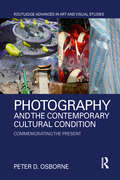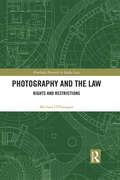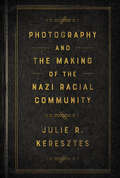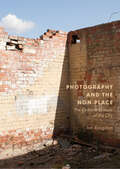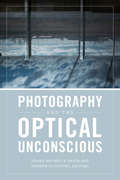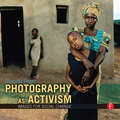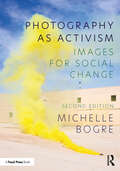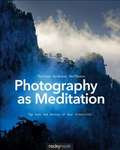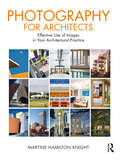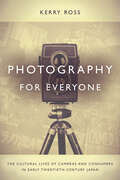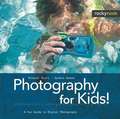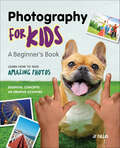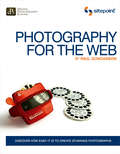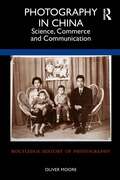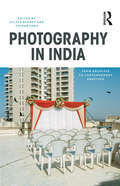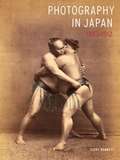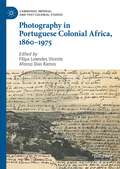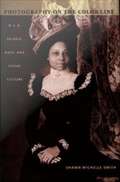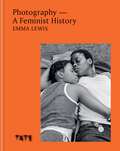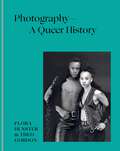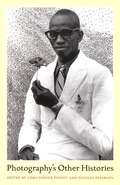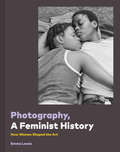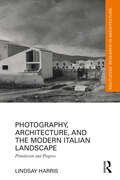- Table View
- List View
Photography and the Contemporary Cultural Condition: Commemorating the Present (Routledge Advances in Art and Visual Studies)
by Peter D. OsborneIn this book, Osborne demonstrates why and how photography as photography has survived and flourished since the rise of digital processes, when many anticipated its dissolution into a generalised system of audio-visual representations or its collapse under the relentless overload of digital imagery. He examines how photography embodies, contributes to, and even in effect critiques how the contemporary social world is now imagined, how it is made present and how the concept and the experience of the Present itself is produced. Osborne bases his discussions primarily in cultural studies and visual cultural studies. Through an analysis of different kinds of photographic work in distinct contexts, he demonstrates how aspects of photography that once appeared to make it vulnerable to redundancy turn out to be the basis of its survival and have been utilised by much important photographic work of the last three decades.
Photography and the Law: Rights and Restrictions (Routledge Research in Media Law)
by Michael O’FlanaganPhotographers and publishers of photographs enjoy a wide range of legal rights including freedom of expression and of publication. They have a right to create and publish photographs. They may invoke their intellectual, moral and property rights to protect and enforce their rights in their created and/or published works. These rights are not absolute. This book analyses the various legal restrictions and prohibitions, which may affect these rights. Photography and the Law investigates the legal limitations faced by professional and amateur photographers and photograph publishers under Irish, UK and EU Law. Through an in-depth discussion of the personal rights of the public, including the right not to be harassed, the book gives a clear analysis of the current legal standpoint on the relationship between privacy and freedom of expression. Additionally, the book looks at the reconciliation of photographers’ rights with the state’s interest in public security and defence, alongside the enforcement of ethical and moral codes. Comparative legal standing in the European Union is used as a springboard to further analyse Irish and UK statutes and case law, including recent reforms and current proposals for future change. The book ends with pertinent suggestions of the necessary reforms and enactments required to rebalance the relationship between the personal rights of individuals, the state’s duties and the protection of photographers’ and photograph publishers’ rights. By clearly explaining the theoretical and conceptual reasoning behind the current law, alongside proposed reforms, the book will be a useful tool for any student or academic interested in photography law, privacy and media law, alongside professional and amateur photographers and photograph publishers.
Photography and the Making of the Nazi Racial Community
by Julie R. KeresztesPhotography and the Making of the Nazi Racial Community examines the role of photography in the construction of the Nazi Volksgemeinschaft, a racially exclusive community, during the Third Reich. Julie R. Keresztes explores how the dictatorship promoted photography for those who belonged to that community and excluded Jews from the practice. As Nazi officials dispossessed Jewish photographers and robbed them of their equipment, studios, and eventually their lives, they made photography more accessible to non-Jewish Germans. But they inadvertently created spaces for photography to be used as resistance and revenge in concentration camps, where forced laborers salvaged photographs that exposed the extermination of Europe's Jews. As the victims of Nazi persecution used photography to gather evidence of the Holocaust, German troops and their families used photography to portray themselves as dutiful members of the Volksgemeinschaft rather than show the reality of war and genocide. Ultimately, Photography and the Making of the Nazi Racial Community shows how the configuration of photography along racial lines shaped the imagery of the Second World War.Published in Association with the US Holocaust Memorial Museum.
Photography and the Non-Place: The Cultural Erasure Of The City
by Jim BrogdenThis book presents a critical and aesthetic defence of “non-place” as an act of cultural reclamation. Through the restorative properties of photography, it re-conceptualises the cultural significance of non-place. The non-place is often referred to as “wasteland”, and is usually avoided. The sites investigated in this book are located where access and ownership are often ambiguous or in dispute; they are places of cultural forgetting. Drawing on the author’s own photographic research-led practice, as well as material from photographers such as Ed Ruscha, Joel Sternfeld and Richard Misrach, this study employs a deliberately allusive intertexuality to offer a unique insight into the contested notions surrounding landscape representation. Ultimately, it argues that the non-place has the potential to reveal a version of England that raises questions about identity, loss, memory, landscape valorisation, and, perhaps most importantly, how we are to arrive at a more meaningful place.
Photography and the Optical Unconscious
by Shawn Michelle Smith Sharon SliwinskiPhotography is one of the principal filters through which we engage the world. The contributors to this volume focus on Walter Benjamin's concept of the optical unconscious to investigate how photography has shaped history, modernity, perception, lived experience, politics, race, and human agency. In essays that range from examinations of Benjamin's and Sigmund Freud's writings to the work of Kara Walker and Roland Barthes's famous Winter Garden photograph, the contributors explore what photography can teach us about the nature of the unconscious. They attend to side perceptions, develop latent images, discover things hidden in plain sight, focus on the disavowed, and perceive the slow. Of particular note are the ways race and colonialism have informed photography from its beginning. The volume also contains photographic portfolios by Zoe Leonard, Kelly Wood, and Kristan Horton, whose work speaks to the optical unconscious while demonstrating how photographs communicate on their own terms. The essays and portfolios in Photography and the Optical Unconscious create a collective and sustained assessment of Benjamin's influential concept, opening up new avenues for thinking about photography and the human psyche. Contributors. Mary Bergstein, Jonathan Fardy, Kristan Horton, Terri Kapsalis, Sarah Kofman, Elisabeth Lebovici, Zoe Leonard, Gabrielle Moser, Mignon Nixon, Thy Phu, Mark Reinhardt, Shawn Michelle Smith, Sharon Sliwinski, Laura Wexler, Kelly Wood, Andrés Mario Zervigón
Photography as Activism: Images for Social Change
by Michelle BogreYou want to look through the lens of your camera and change the world. You want to capture powerful moments in one click that will impact the minds of other people. Photographic images are one of the most popular tools used to advocate for social and environmental awareness. This can be as close to home as drug use, prostitution, or pollution or as far away as famine, war, and the plight of refugees and migrant workers. One well-known example of an activist photographer would be landscape photographer Ansel Adams, who trudged to Washington with stunning images of the American west to advocate protecting these areas. His images and testimony were instrumental in creating the National Park System and garnering specific protection for Yellowstone National Park. More recently Robert Glenn Ketchum's images of Alaska's Arctic National Wildlife Refuge raised awareness of why this area should be protected. Nigel Barker's seal photographs advocates against seal clubbing. What is your cause and how can you use your camera to make the world a better place?This book provides a comprehensive theory of, and history of, photography as activism. It also includes interviews with contemporary photographers. It is a call to action for young photographers to become activists, a primer of sorts, with advice for how to work with NGOs and non-profits, how to work safely in conflict zones and with suggestions for distribution on websites, blogs, and interactive agencies.
Photography as Activism: Images for Social Change
by Michelle BogreThis fully revised and updated second edition of Photography as Activism is both a study of activist photography, and a call to action. It offers students and documentary photographers insights into the theory, history, philosophy, and practice of photography as activism.The book is lavishly illustrated with 85 key historical and contemporary images. Chapters have been revised to include contemporary ideas about representation, gaze, agency, and decolonizing the camera, as well as an expanded history that includes work from the global South and the civil rights movements in the US. A new fourth chapter focuses on activist practices that go beyond traditional reportage. It features 19 new interviews and updates on the original interviews. Photographers talk about their practices, the challenges they face in the twenty-first century, advice on working with NGOs and non-profits, and how to form partnerships to expand the dissemination of their work.Photography as Activism is an essential text for courses on documentary and photojournalism, and those that explore art as social change more broadly, but also a call to action for young photographers to pick up their cameras and advocate for change.
Photography as Meditation
by Torsten Andreas HoffmannFor many people, photography serves as a form of meditation; a way to separate themselves from their stressful lives. In this book, Torsten Andreas Hoffmann explores an approach to artistic photography based on Japanese Zen-Philosophy. Meditation and photography have much in common: both are based in the present moment, both require complete focus, and both are most successful when the mind is free from distracting thoughts. Hoffman shows how meditation can lead to the source of inspiration.Hoffman's impressive images of landscapes, cities, people, and nature, as well as his smart image analysis and suggestions about the artistic process, will help you understand this approach to photography without abandoning the principles of design necessary to achieve great images. Photographing busy scenes, especially, requires an inner calm that enables you to have intuition for the right moment and compose a well-balanced image amidst the chaos.The goal of this book is to develop your photographic expression. It provides enrichment for photographers who believe that only technical mastery produces great images and shows how important it is to engage with your own awareness to act creatively.
Photography for Architects: Effective Use of Images in Your Architectural Practice
by Martine Hamilton KnightWe live in a world driven by images, but with so much visual noise, is anyone really looking? How does an architect ensure their portfolio is within view of the right audience? Photographs are still as vital to architectural practice as they ever were. However, creation and circulation, once in the hands of skilled professionals, is now perceived as being ‘free’ and within easy reach of all. But where is the clarity? What is the message? By setting out the case for curated image making, considered photography may again be placed at the centre of architectural marketing strategies. Photography for Architects guides the reader through various topics: from establishing a visual brand and sharing images online, to producing content in-house and commissioning professionals. It explores the still and moving image, creating books and exhibitions for legacy value, compiling award entries, and engaging with trade press. Little understood aspects regarding legal rights and obligations, ethics, copyright, and licensing images for use are discussed in clear language. Multiple photographic examples and conversations with international practitioners highlight the various themes throughout. Written by a working architectural photographer whose life has been spent in commercial practice, this easy-to-read, richly illustrated guide is essential reading for architects and designers alike who are working with images and image makers.
Photography for Everyone: The Cultural Lives of Cameras and Consumers in Early Twentieth-Century Japan
by Kerry RossThe Japanese passion for photography is almost a cliché, but how did it begin? Although Japanese art photography has been widely studied this book is the first to demonstrate how photography became an everyday activity. Japan's enthusiasm for photography emerged alongside a retail and consumer revolution that marketed products and activities that fit into a modern, tasteful, middle-class lifestyle. Kerry Ross examines the magazines and merchandise promoted to ordinary Japanese people in the early twentieth century that allowed Japanese consumers to participate in that lifestyle, and gave them a powerful tool to define its contours. Each chapter discusses a different facet of this phenomenon, from the revolution in retail camera shops, to the blizzard of socially constructive how-to manuals, and to the vocabulary of popular aesthetics that developed from enthusiasts sharing photos. Ross looks at the quotidian activities that went into the entire picture-making process, activities not typically understood as photographic in nature, such as shopping for a camera, reading photography magazines, and even preserving one's pictures in albums. These very activities, promoted and sponsored by the industry, embedded the camera in everyday life as both a consumer object and a technology for understanding modernity, making it the irresistible enterprise that Eastman encountered in his first visit to Japan in 1920 when he remarked that the Japanese people were "almost as addicted to the Kodak habit as ourselves."
Photography for Kids!
by Sandra Abend Michael EbertDigitization is the biggest advance in the history of photography. While some seasoned photographers may still be wary of the filmless technique, unbiased children have easily found their way into the digital world. Children are excited by the instant gratification of capturing an image and immediately seeing the result. With today's digital cameras, what used to be an expensive and disappointing process is now as easy as pie. Enthusiastic and confident children are able to handle digital cameras with remarkable skill. The instant feedback motivates them to continue exploring, and soon they are able to create small masterpieces full of inspiration and fantasy. Photography for Kids introduces children between the ages of 8 and 14 to the world of photography. Technical concepts--like how a digital camera actually works--are explained in a way that is easy for children to understand. The book emphasizes creativity and presents techniques for capturing exciting images.
Photography for Kids: A Beginner's Book
by JP PullosBecome a photographer with this guide to photography for kids ages 8 to 12A good photo can tell a story, express your creativity, and document moments from your life in a way that only you can capture. Learn how to create incredible images that are uniquely yours with this guide to photography for kids. All you need is the most basic digital camera or smartphone camera—no fancy equipment required. You'll learn all about framing, composition, lighting, depth, dimension, and lines. Then, put your new knowledge into practice with engaging exercises that include step-by-step instructions.This book about photography for kids includes:Photography fundamentals—Discover how a camera works, a brief history of photography, what makes a photo good, and a checklist for getting started.Example photos—Explore high-quality photographs that illustrate the concepts you're learning and inspire you to get creative.Tips and how-tos—Find pointers that explain the technical details of great photos and show you ways to make adjustments in a variety of real-life situations.Discover the joy of photography with this beginner-friendly book about photography for kids.
Photography for the Web: Discover How Easy It Is To Create Stunning Photographs (Sitepoint Ser.)
by Paul DuncansonA hands-on on guide to digital photography, with a practical focus on the Web. Readers will learn how to make the most of their digital camera, while learning the basics of composition, exposures, filters and more.Step-by-step guides will walk readers through advance techniques like using long exposures, photographing items in motion, and the importance of the RAW data format."Photography for the Web" will also offer helpful advice on editing images (levels, colors, histograms), correcting for barrel distortions and vanishing points, removing blemishes, going black & white and stitching panoramas.Finally, the book will discuss sharing images online, utilizing online communities like Flickr & Fotalia, competitions for amateur photographers and selling photos on stock image sites like iStockPhoto.
Photography in China: Science, Commerce and Communication (Routledge History of Photography)
by Oliver MooreEmphasizing the medium’s reception among several Chinese constituencies, this book explores photography’s impact within new discourses on science, as well as its effects in social life, visual modernity and the media during China’s transition from imperial to republican government. General knowledge and academic teaching of early modern Chinese visual culture stops short of fitting photography into the larger context of visual practices and theories. This study redraws the boundaries by making photography the central concern within changing priorities of visual representation and its functions during a period of major cultural and political change. No other study draws on such intimate familiarity with the early glamour of photography as science, commerce and communication in the various local conditions of China’s cities and towns. Joining a body of critical writing that examines photography’s histories outside the familiar confines of the West, this book looks beyond the tourist and imperialist gazes of photographer-adventurers from the Western powers and Japan. It defines instead the Chinese priorities of photographic vision that are abundantly evident in surviving photographs as well as in records as various as technical manuals and personal inscriptions. Local practices and local knowledge are the keys to explain the highly successful indigenization of a medium as globalizing as photography with reference to Chinese society’s own terms and practices. This book will be of particular interest to scholars in art and visual culture, the history of photography and Asian art.
Photography in India: From Archives to Contemporary Practice
by Aileen BlaneyPhotography’s prominence in the representation and experience of India in contemporary and historical times has not guaranteed it a position of sustained attention in research and scholarship. For a technology as all pervasive as photography, and a country as colossal as India, this scenario is somewhat of an anomaly. Photography in India explores elements of the past, present and future of photography in the context of India through speculation and reflection on photography as an artistic, documentary and everyday practice. The perspectives of writers, theorists, curators and artists are selectively brought to bear upon known as well as previously unseen photographic archives, together with changes in photographic practice that have been synchronous with contemporary India’s rapid urban and rural transformation and the technological shift from chemistry and light to programming and algorithms. Essential reading for anyone interested in Indian photography, this book binds insights into a history of photography with its contemporary development, consolidating wide-ranging thinking on the topic and setting the agenda for future research.
Photography in Japan 1853 - 1912
by Terry BennettPhotography in Japan 1853-1912 is an authoritative and unique visual record of Japan's metamorphosis from a feudal society to a modern, industrial nation. The 350 old and rare images in this book, most of them published here for the first time, not only chronicle the introduction of photography in Japan, but also demonstrate how early photographic images are vital in helping to understand the dramatic changes that occurred in Japan during the mid-nineteenth century. Taken between 1853 and 1912 by the most important Japanese and foreign photographers working in Japan, these photographic images, whether sensational or everyday, intimate or panoramic, document a nation about to abandon its traditional ways and enter the modern era. This is the first book to document the history of photography in Japan in a comprehensive and systematic way.
Photography in Japan 1853 - 1912
by Terry BennettPhotography in Japan 1853-1912 is an authoritative and unique visual record of Japan's metamorphosis from a feudal society to a modern, industrial nation. The 350 old and rare images in this book, most of them published here for the first time, not only chronicle the introduction of photography in Japan, but also demonstrate how early photographic images are vital in helping to understand the dramatic changes that occurred in Japan during the mid-nineteenth century. Taken between 1853 and 1912 by the most important Japanese and foreign photographers working in Japan, these photographic images, whether sensational or everyday, intimate or panoramic, document a nation about to abandon its traditional ways and enter the modern era. This is the first book to document the history of photography in Japan in a comprehensive and systematic way.
Photography in Portuguese Colonial Africa, 1860–1975 (Cambridge Imperial and Post-Colonial Studies)
by Filipa Lowndes Vicente Afonso Dias RamosThis edited collection presents the first critical and historical overview of photography in Portuguese colonial Africa to an English-speaking audience. Photography in Portuguese Colonial Africa, 1860–1975 brings together sixteen scholars from interdisciplinary fields as varied as history, anthropology, art history, visual culture and museum studies, to consider some of the key aspects in the visual representation of the longest-lasting European colonial empire in the African continent. The chapters span over two centuries and cover five formerly colonial territories – Angola, Cabo Verde, Guinea-Bissau, Mozambique, and São Tomé and Príncipe – deploying a range of methodologies to explore the multiple meanings and the contested uses of the photographic image across the realms of politics, science, culture and war. This book responds to a marked surge of international interest in the relationship between photography and colonialism, which has hitherto largely overlooked the Portuguese imperial context, by delivering the most recent scholarly findings to a broad readership.
Photography on the Color Line: W. E. B. Du Bois, Race, and Visual Culture
by Shawn Michelle SmithThrough a rich interpretation of the remarkable photographs W. E. B. Du Bois compiled for the American Negro Exhibit at the 1900 Paris Exposition, Shawn Michelle Smith reveals the visual dimension of the color line that Du Bois famously called "the problem of the twentieth century." Du Bois's prize-winning exhibit consisted of three albums together containing 363 black-and-white photographs, mostly of middle-class African Americans from Atlanta and other parts of Georgia. Smith provides an extensive analysis of the images, the antiracist message Du Bois conveyed by collecting and displaying them, and their connection to his critical thought. She contends that Du Bois was an early visual theorist of race and racism and demonstrates how such an understanding makes the important concepts he developed--including double consciousness, the color line, the Veil, and second sight--available to visual culture and African American studies scholars in powerful new ways. Smith reads Du Bois's photographs in relation to other turn-of-the-century images such as scientific typologies, criminal mugshots, racist caricatures, and lynching photographs. By juxtaposing these images with reproductions from Du Bois's exhibition archive, Smith shows how Du Bois deliberately challenged racist representations of African Americans. Emphasizing the importance of comparing multiple visual archives, Photography on the Color Line reinvigorates understandings of the stakes of representation and the fundamental connections between race and visual culture in the United States.
Photography – A Feminist History
by Emma Lewis***'An epic and fascinating book.' The BooksellerHow did the abolitionist movement interact with women's entry into the field of photography? What does the medium have to do with menstrual taboos? Is there even such a thing as a 'feminist image'?Whether working in the studio or on the front line, women have contributed to every aspect of photography's short history. For some, gender is front and centre; for others, it's merely incidental. All have been affected by the power structures beyond their camera lenses. Far too many have been, and continue to be, overlooked.Mapping photographic developments against shifting gender rights and roles, Photography - A Feminist History shines a light on how photography has borne witness to women's movements and made the causes for which they fight visible, and how, in turn, different approaches to feminism have given us ways of understanding photographs. Authoritative and international in scope, Photography - A Feminist History features over 140 photographers, with ten thematic essays, and extended profiles on 75 key practitioners, many informed by conversations with the author.
Photography – A Queer History
by Flora Dunster Theo GordonPhotography - A Queer History examines how photography has been used by artists to capture, create and expand the category 'Queer'. It bookmarks different thematic concerns central to queer photography, forging unexpected connections to showcase the diverse ways the medium has been used to fashion queer identities and communities.How has photography advanced fights against LGBTQ+ discrimination? How have artists used photography to develop a queer aesthetic? How has the production and circulation of photography served to satisfy the queer desire for images, and created transnational solidarities?Photography - A Queer History includes the work of 84 artists. It spans different historical and national contexts, and through a mix of thematic essays and artist-centred texts brings young photographers into conversation with canonical images.
Photography – A Queer History
by Flora Dunster Theo GordonPhotography - A Queer History examines how photography has been used by artists to capture, create and expand the category 'Queer'. It bookmarks different thematic concerns central to queer photography, forging unexpected connections to showcase the diverse ways the medium has been used to fashion queer identities and communities.How has photography advanced fights against LGBTQ+ discrimination? How have artists used photography to develop a queer aesthetic? How has the production and circulation of photography served to satisfy the queer desire for images, and created transnational solidarities?Photography - A Queer History includes the work of 84 artists. It spans different historical and national contexts, and through a mix of thematic essays and artist-centred texts brings young photographers into conversation with canonical images.
Photography's Other Histories (Objects/Histories)
by Nicolas Peterson Christopher PinneyThis collection presents a radically different account, describing photography as a globally disseminated and locally appropriated medium. Essays firmly grounded in photographic practice--in the actual making of pictures--suggest the extraordinary diversity of nonwestern photography.
Photography, A Feminist History
by Emma LewisThis feminist retelling of the history of photography puts women in the picture—and, more importantly, behind the camera!In ten thematic, chronological sections, Tate Modern curator Emma Lewis explores the vital role women artists have played in shaping the ever-evolving medium of photography. Lewis has compiled work from more than 200 different women and nonbinary photographers along with short essays on 75 different artists, many informed by her interviews with the subjects. From the studio portraiture of the late nineteenth century to the photojournalism of Dorothea Lange and Lee Miller in the early twentieth—and from second-wave feminist critiques of gender roles to contemporary selfies and social media personae—this volume examines different genres, styles, and approaches to photography from the 1800s to the present.UNPARALLELED IN SCOPE: International, inclusive, and intersectional, this comprehensive volume tells the story of a versatile and innovative medium. From early-twentieth-century self-portraits responding to modernity and changing notions of womanhood, to photojournalistic images documenting the climate crisis, the photographs in this book demonstrate the varied ways that women respond to and shape the global cultural landscape. The artists profiled here include:• Sheila Pree Bright• Imogen Cunningham• Paz Errázuriz• Nan Goldin• Kati Horna• Mari Katayama• Dora Maar• Lee Miller• Tina Modotti• Zanele Muholi• Shirin Neshat• Cindy Sherman• Lieko Shiga• Lorna Simpson• Amalia Ulman• And more!INSIGHTFULLY ORGANIZED: The thematic chapters of this project showcase photography's changing role in society and art. They allow the author to explore and contextualize how this role has (or hasn't) made space for women and people of marginalized genders, and how the work done on the margins of the medium pushes the boundaries of technology and creative expression. This is not simply a collection of "women photographers"—it's a book about how and why women and nonbinary artists have used photography to respond to and shape their own realities.Perfect for:• Photographers, artists, and students, and art lovers• Anyone interested in the history of photography• Intersectional feminists• Trailblazing women—and the people who love and support them!
Photography, Architecture, and the Modern Italian Landscape: Primitivism and Progress (Routledge Research in Architecture)
by Lindsay HarrisPhotography, Architecture, and the Modern Italian Landscape explores the impact of photography at a pivotal moment in Italian architecture and culture, focusing on the period between 1910 and the mid-1970s.The book analyzes architectural photographs taken by Italian cultural figures who helped transform the Italian landscape into what we know today. This study charts the oscillation of Italians’ ideas about what progress signified. For example, the book demonstrates that for writers and artists familiar with ancient ideas about civilization in 1910, the Roman countryside exemplified the contradictions inherent in primitivism. On the one hand, their photographs praised the region’s primordial beauty, yet their images condemned the crudeness of local living conditions. More broadly, it traces the history of primitivism and photography in Italy to show how cultural leaders’ alarm at the nation’s pre-modern living conditions, their aspiration to modernize them, and their grasp of photography to catalyze the process helped forge the modern Italian landscape—its monuments, housing, infrastructure, and natural environments. At the same time, it explores a vibrant period in photographic history when the advent of photographic reproduction as a commercial process developed into a medium with its own visual style capable of shaping ideas about modernity. This new image-making and reproduction technology empowered Italy’s cultural leaders not simply to represent the Italian landscape through photography but to determine how it developed.Of interest to researchers and students from a range of disciplines, modern architecture, photography, and Italian studies, this book demonstrates the power of art to transform society and to reformulate our ideas of progress.
